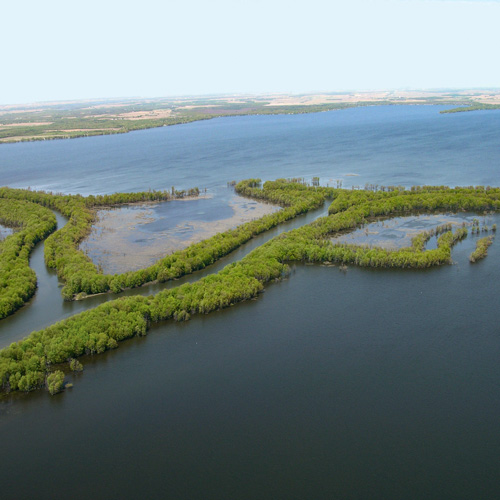Missisquoi Bay Agreement
(Français)

Vermont and Québec share Missisquoi Bay and its 1,200 mi2 (3,100 km2) watershed. The bay’s water quality has deteriorated in recent decades, and it experiences troublesome cyanobacteria blooms nearly every summer. Recognizing the need to reduce pollution entering the bay, the two governments established a formal commitment in 2002 to share responsibility for its cleanup. In 2021, the jurisdictions renewed the agreement, which included a target for in-lake phosphorus concentration in the bay.
The signing of this agreement fulfills a high priority action of the Lake Champlain Management Plan, Opportunities for Action, implemented by the Lake Champlain Basin Program and its partners. The Missisquoi Bay Agreement’s target phosphorus concentrations are also consistent with target concentrations that are the basis of the 2016 Phosphorus Total Maximum Daily Loads (TMDLs) for Vermont Segments of Lake Champlain. VT ANR and VAAFM identified a suite of actions necessary to implement in the Vermont portion of the Missisquoi Bay watershed in order to achieve the target phosphorus loads that Vermont committed to achieving and maintaining. These actions include wastewater treatment plant upgrades, best management practices on farms to reduce nutrient runoff, stabilization of stream banks and stream channels, and better stormwater management and erosion control on developed land and roadways.
In Spring 2020 the International Joint Commission completed a binational Water Quality Study on Missisquoi Bay. The IJC published the findings of the study in the report Nutrient Loading and Impacts in Lake Champlain – Missisquoi Bay and Lake Memphremagog. The report includes a review of hydrological conditions and sources and impacts of nutrients in the Missisquoi Basin and provides recommendations to the Canadian and U.S. governments on steps to reduce harmful algal blooms.
Missisquoi Bay Plans and Documents
- Lake Champlain Public Meeting Summary on Missisquoi Bay Water Quality Improvement Initiatives, June 2023 English | Français
- Missisquoi Bay Phosphorus Reduction Agreement, April 2021 English | Français
- Phosphorus Loading to Missisquoi Bay from Sub-Basins in Vermont and Québec, 2002-2005 | Apport de phosphore vers la baie Missisquoi en provenance des sous-bassins du Vermont et du Québec, 2002 à 2005 November 25, 2008 English | Français
- Plan d’action concertée de la Corporation Bassin Versant Baie Missisquoi, Bilan 2000-2005, March 2006 Français
- Corporation Bassin Versant Baie Missisquoi Rapport Annuel, 2005-2006, June 2006 Français
- Reduction du Phosphore Baie Missisquoi, Bilan des actions 2005-2006, July 2005 Français | Executive Summary in English
- Missisquoi Bay Watershed Phosphorus Load Monitoring Workplan, May 2005 English | Français
- Final report to the International Joint Commission, October 20, 2004
- Missisquoi Bay Phosphorus Reduction Action Plan 2003-2009, September 2004 English
- Missisquoi Bay Phosphorus Reduction Agreement, August 2002 English | Français
- Addendum to Missisquoi Bay Phosphorus Reduction Task Force Report, October 2001 English | Français
- Missisquoi Bay Phosphorus Reduction Task Force Report, June 2000 English | Français
- Missisquoi Bay Basin / Bassin versant de la baie Missisquoi (Francais)
- Missisquoi Bay Critical Source Area Study Report and Online Map